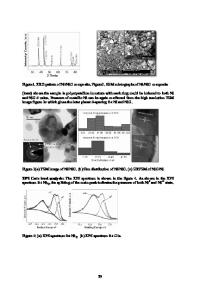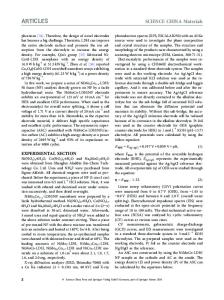Ni–Co composite metal embedded porous N-doped carbon for an effective binder-free supercapacitor electrode
- PDF / 754,407 Bytes
- 12 Pages / 584.957 x 782.986 pts Page_size
- 5 Downloads / 789 Views
ndi Shi Guangdong Guangya High School, Guangzhou 510160, People’s Republic of China
Guiqiang Diao School of Chemistry and Material Engineering, Huizhou University, Huizhou 516007, Guangdong, People’s Republic of China
Xiyue Zhangb) MOE of the Key Laboratory of Bioinorganic and Synthetic Chemistry, School of Chemistry, Sun Yat-Sen University, Guangzhou 510275, People’s Republic of China (Received 7 September 2017; accepted 16 November 2017)
Binary transition metal oxides, such as NiCo2O4 (NCO) electrode have been demonstrated to be promising candidates for high-performance supercapacitors. However, their low electrical conductivity and poor stability made the electrochemical performance of most current NCO electrodes yet below the expectation. Herein, a novel electrode (NCC) consisting of binary transition metal (Ni– Co) nanoparticles embedded N-doped porous carbon matrix on graphite papers (GPs) has been developed with a high specific capacitance of 933.5 F/g at 1 mA/cm2 which is substantially 10 times than that of the NCO electrode (99.3 F/g) and much higher than those of most reported NCO based electrode. Moreover, this NCC electrode has an ultrahigh rate capability of 725.5 F/g at 10 mA/cm2 with excellent electrochemical durability (no capacitance decreases after 10,000 cycles). These results indicate a promising potential application of Ni–Co metal composite embedded carbon matrix for using as an effective electrode material in supercapacitors.
I. INTRODUCTION
As for the lack of fossil fuel-energy sources and increasingly worsened environmental pollution, everincreasing demands for renewable energy technologies have stimulated extensive interest in the development of energy storage devices and efficient energy harvesters, without doing harm to our environment.1–3 Supercapacitors (SCs), also known as electrochemical capacitors or ultracapacitors, have the advantages of rapid charge–discharge response, simple operating mechanisms, favorable safety, high specific power, and long operating life (.100,000 cycles), and therefore have been widely recognized as one of the efficient energy-storage devices from both the academia and industry.4 In this context, SCs plays a vital role in highpower electronic devices, hybrid electric vehicles, and emergency power supplies. Nevertheless, the relatively lower energy density of SCs than that of batteries makes it the bottleneck of these energy devices, dramatically Contributing Editor: Tianyu Liu Address all correspondence to these authors. a) e-mail: [email protected] b) e-mail: [email protected] DOI: 10.1557/jmr.2017.454
restricting their practical applications as the primary power sources. Therefore, considerable efforts for SCs studies have been intensively devoted toward increasing the energy density, and significant progress has been made recently.5–7 It is generally accepted that the rational design and controllable synthesis of the nanostructured electrode with large surface areas and good structural stability is one promising strategy in solving this bottle
Data Loading...











